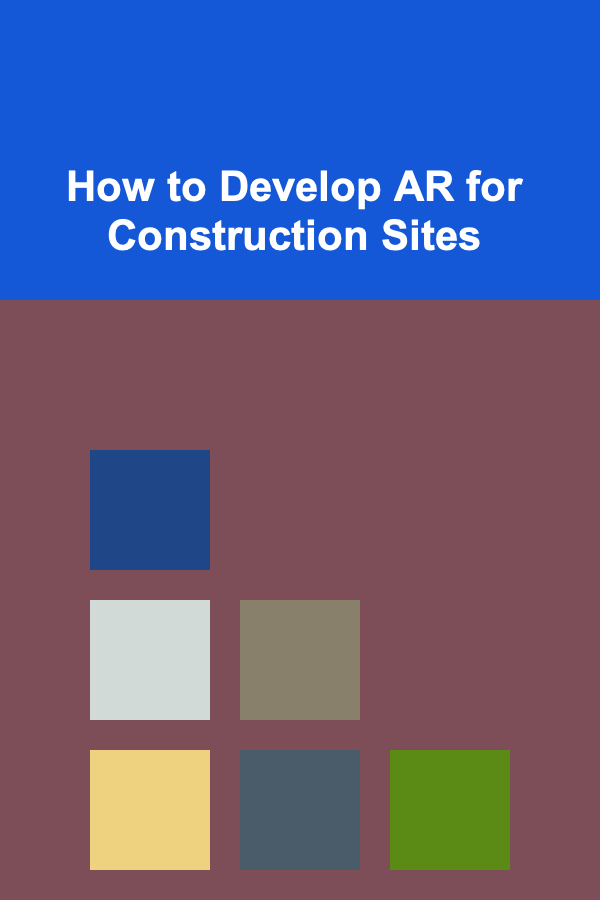
How to Develop AR for Construction Sites
ebook include PDF & Audio bundle (Micro Guide)
$12.99$11.99
Limited Time Offer! Order within the next:

Augmented Reality (AR) has become one of the most promising technologies in the construction industry, offering new ways to enhance project efficiency, accuracy, safety, and collaboration. With AR, construction professionals can visualize complex 3D models, overlay digital information on physical spaces, and improve decision-making in real-time. As the demand for more advanced technology increases in the construction sector, AR is poised to play a pivotal role in transforming how construction projects are managed and executed.
In this article, we will explore how AR can be developed for construction sites, focusing on the processes, challenges, technologies, and benefits associated with integrating AR into construction workflows.
What is AR and How Does it Work?
Before diving into how to develop AR for construction sites, it's essential to understand what AR is and how it works. AR is a technology that overlays digital information---such as images, sounds, or 3D models---onto the physical world in real-time. This is typically done through the use of devices such as smartphones, tablets, smart glasses, or headsets. AR enhances the user's perception of the real world by integrating digital elements seamlessly with the physical environment.
In construction, AR can provide real-time data visualization, display building information models (BIM), and simulate construction processes, helping workers and project managers make more informed decisions.
Benefits of AR in Construction
AR can provide numerous advantages in construction projects, making it a valuable tool for improving various aspects of the construction process. Some of the primary benefits include:
1. Improved Design Visualization
One of the most significant advantages of AR is the ability to visualize complex 3D designs in real-world environments. Architects, engineers, and construction professionals can use AR to overlay building designs on actual construction sites. This allows teams to see how a design will look once implemented, making it easier to detect potential issues early in the project.
For example, AR can help identify problems such as clashes between structural elements and utility systems, giving teams a chance to resolve these conflicts before physical construction begins. This early intervention can lead to cost savings and prevent delays.
2. Enhanced Collaboration and Communication
AR can improve communication between different stakeholders, including architects, engineers, contractors, and clients. Using AR, team members can visualize and interact with the same digital content in real-time, facilitating better collaboration. This reduces the risk of misunderstandings and ensures everyone is on the same page regarding project details.
For example, a construction manager can walk through a site while wearing AR glasses, viewing real-time data and making adjustments as needed. This allows for better decision-making and faster problem resolution.
3. Increased Safety on Construction Sites
Safety is a top priority in construction, and AR can play a crucial role in enhancing safety protocols. By overlaying safety guidelines, hazard warnings, and other important information onto the physical environment, AR helps workers stay informed about potential dangers.
For example, AR glasses can display real-time warnings about hazardous conditions, such as unstable scaffolding or high voltage areas, preventing accidents before they happen. Additionally, AR can be used for safety training, simulating dangerous scenarios and providing immersive learning experiences.
4. Improved Project Management and Efficiency
AR can streamline project management by providing real-time data and performance metrics. Construction managers can use AR to track the progress of a project, compare completed work with digital blueprints, and detect discrepancies in real time.
Moreover, AR can assist with project scheduling by visualizing timelines and identifying any delays or bottlenecks. This enhances decision-making and helps ensure that construction projects stay on track.
5. Accurate Measurements and Field Data Collection
AR can also facilitate accurate measurements and data collection on construction sites. With AR-enabled devices, workers can measure distances, angles, and areas directly from the site, eliminating the need for traditional measuring tools.
This data can then be integrated into the Building Information Model (BIM), improving the accuracy of project documentation and reducing errors in construction processes. This level of precision can also lead to cost savings, as it reduces the need for rework and material wastage.
Steps for Developing AR for Construction Sites
Developing AR for construction sites involves a combination of hardware, software, and integration with other technologies such as BIM. Below are the key steps involved in developing AR solutions for construction projects:
1. Define the Objectives and Use Cases
The first step in developing AR for construction is to clearly define the objectives and use cases for the technology. AR can be used for various purposes in construction, such as design visualization, safety monitoring, or progress tracking. Identifying specific use cases helps determine the features and functionalities required for the AR solution.
For example, if the goal is to improve safety, the AR system may need to overlay hazard warnings or display safety procedures. If the focus is on design visualization, the AR solution may need to integrate with BIM software to overlay 3D models on the construction site.
2. Choose the Right AR Hardware
Choosing the right hardware is crucial for the successful implementation of AR in construction. There are several types of AR devices available, including:
- Smartphones and Tablets: These are the most common AR devices used in construction. They are relatively affordable and easy to use. However, they may not offer the same immersive experience as other devices.
- AR Glasses: Devices such as Microsoft HoloLens or Magic Leap One provide a more immersive AR experience. They allow users to see digital information overlaid on the real world without the need to hold a device. However, these devices can be more expensive and require specialized software.
- Wearable Devices: Wearables such as AR helmets or smart goggles offer hands-free interaction with AR content. These devices are ideal for construction workers who need to keep their hands free while using AR technology.
The choice of hardware depends on the specific requirements of the construction project, the level of immersion needed, and the budget available.
3. Integrate AR with Building Information Modeling (BIM)
BIM is a digital representation of the physical and functional characteristics of a building or infrastructure. Integrating AR with BIM allows construction teams to overlay digital models onto the real-world construction site, providing a more accurate representation of the project.
This integration can help teams visualize design plans in real-time and detect potential issues such as clashes or conflicts between different systems. Additionally, BIM data can be used to track project progress, ensuring that construction is proceeding according to plan.
4. Develop the AR Software
Developing the AR software for construction sites involves creating the user interface (UI), interaction models, and AR content. The software must be intuitive and easy to use, as construction workers may not have experience with advanced technology.
Key features to consider when developing AR software for construction include:
- Real-Time Data Integration: The AR system should be able to access real-time data from various sources, including sensors, BIM software, and construction management platforms. This data can be used to update the AR environment and provide accurate, up-to-date information to users.
- Interactive Features: The software should allow users to interact with the AR content, such as rotating 3D models, zooming in on specific areas, or accessing additional information about building components.
- Offline Functionality: Construction sites often have limited internet connectivity, so the AR system should be able to function offline and sync data once a connection is available.
- User-Friendly Interface: The interface should be designed for easy navigation, ensuring that construction workers can quickly access the information they need without unnecessary complexity.
5. Test and Optimize the AR Solution
Once the AR system has been developed, it's essential to conduct thorough testing to ensure its functionality, accuracy, and usability. This testing should be done in a real construction environment to simulate actual conditions and workflows.
During testing, identify any issues related to hardware compatibility, software performance, or user experience. Collect feedback from construction workers and other stakeholders to refine the AR solution and make improvements where necessary.
Optimization is crucial for ensuring that the AR system performs well under the demanding conditions of construction sites. This may involve enhancing the system's speed, improving data accuracy, and refining the user interface.
6. Deploy and Train Users
After testing and optimization, the AR solution can be deployed on the construction site. It's essential to train workers and other stakeholders on how to use the AR technology effectively. Training should focus on how to interact with the AR system, access relevant information, and leverage the technology to improve productivity and safety.
Ongoing support and maintenance are also necessary to ensure that the AR system continues to function as expected throughout the construction project.
Challenges of AR Development for Construction Sites
While AR has great potential for the construction industry, there are several challenges that need to be addressed when developing and implementing AR solutions:
1. Cost and Budget Constraints
Developing and deploying AR technology can be expensive, especially when using high-end hardware such as AR glasses or headsets. Smaller construction firms may struggle to justify the investment in AR, especially if the return on investment (ROI) is not immediately apparent.
However, as AR technology becomes more mainstream, the cost of hardware and software is expected to decrease, making it more accessible to a wider range of construction companies.
2. Technological Limitations
Construction sites can be complex environments with varying lighting conditions, interference from physical structures, and dynamic workflows. AR technology must be able to function effectively in these challenging conditions, which can sometimes limit its accuracy and effectiveness.
For example, AR systems may struggle to accurately overlay digital content in low-light conditions or in areas with obstructed views. Developers must design AR solutions that can handle these challenges to ensure reliable performance on construction sites.
3. User Adoption and Training
Construction workers may be unfamiliar with AR technology, which could make it difficult to achieve widespread adoption. Adequate training and support are essential to ensure that users feel comfortable using the technology and can fully leverage its benefits.
4. Data Integration and Security
AR solutions require integration with other construction management tools, such as BIM software, sensors, and project management platforms. Ensuring seamless data integration and maintaining data security can be complex, especially when dealing with sensitive project information.
Conclusion
Developing AR for construction sites offers numerous opportunities to enhance productivity, safety, and collaboration. By integrating AR with BIM and other construction technologies, project managers and workers can visualize designs, track progress, and make more informed decisions. Although there are challenges related to cost, technology, and user adoption, the benefits of AR in construction are undeniable. As the technology continues to evolve, AR will become an increasingly integral tool for the construction industry, helping to build more efficient, accurate, and safer projects.

How to Improve Your Home Security Without Changing Your Locks
Read More
How to Track Customer Behavior: A Checklist for Better Retention Insights
Read More
How to Use Plants to Brighten Up Your Home on a Budget
Read More
How to Use Virtual Backgrounds to Enhance Meetings
Read More
Understanding the Genetics of Reproductive Health
Read More
How to Grow Your Own Organic Vegetables: A Comprehensive Guide
Read MoreOther Products

How to Improve Your Home Security Without Changing Your Locks
Read More
How to Track Customer Behavior: A Checklist for Better Retention Insights
Read More
How to Use Plants to Brighten Up Your Home on a Budget
Read More
How to Use Virtual Backgrounds to Enhance Meetings
Read More
Understanding the Genetics of Reproductive Health
Read More